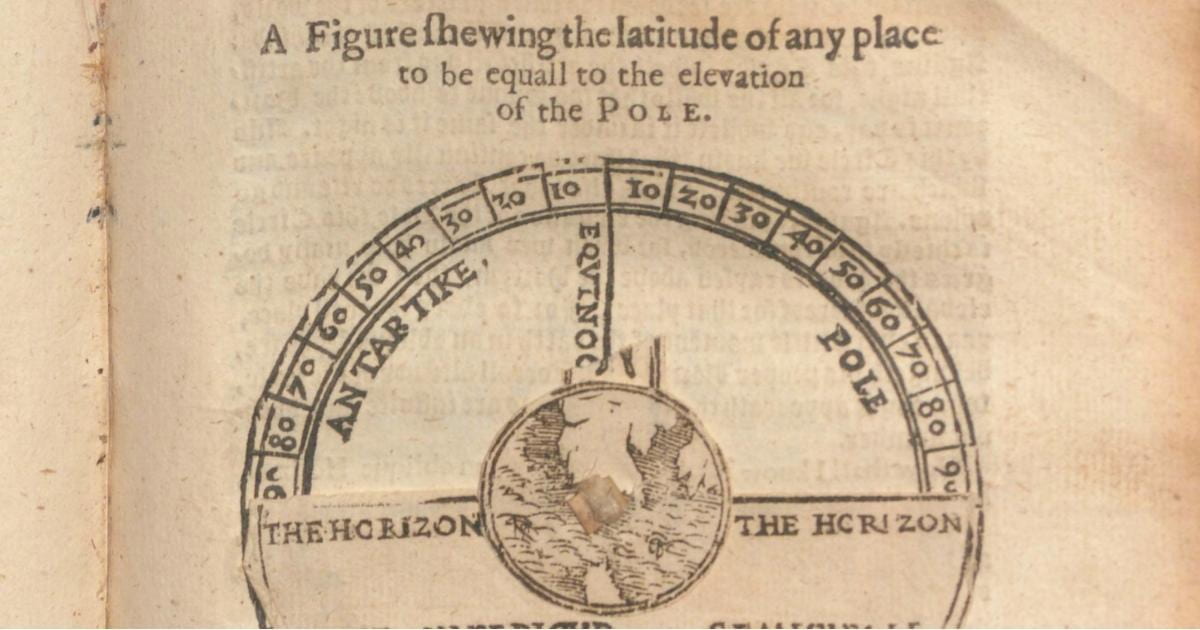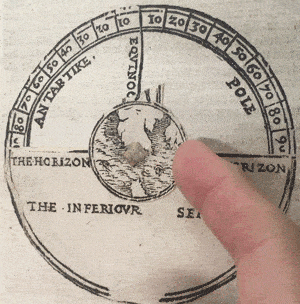To mark this year’s 20th anniversary of Special Collections, the curators have selected some intriguing items for the Twenty at 20 series. Here is number ten.
Interactive wheel charts
Labelled as “A Figure shewing the latitude of any place to be equall to the elevation of the Pole”, the volvelle has two independently rotating parts. They are attached with string through the centre of the volvelle base circle3 which is printed on the page and marked with degrees and labels for the poles, “Antartike”, “Artike” and “Equinocial”. The top-most revolving circle features an illustration of a map; the lower rotating semicircle shows the horizon line and retains a fragment of the narrow, rectangular-shaped pointer that, when complete, showed the figure of a man with one arm pointing upwards and the word Zenit[h].
The other two volvelles sometimes found in this edition are sadly lacking in our copy, although the printed base leaf circles have holes pierced through the centres suggesting they might have been assembled at some point.4
On the page facing the surviving paper tool, Blundeville (ca 1522-1606) instructed readers to try it out using the coordinates for Norwich, England, a town near his home in Newton Flotman.
Nearly 400 years later, it is tempting to imagine a 17th century reader, after successfully completing the Norwich exercise, turning the wheels using their own town’s coordinates as they – literally and figuratively – navigated the book’s content.5
View in person
- View the volvelle and another from a 19th century geography text at Special Collections, Level G, General Library Te Herenga Mātauranga Whānui, until 11 August.
Jo Birks, Special Collections
References
1 Helfand, J. (2002). Reinventing the wheel. New York: Princeton Architectural Press. Myers, A.K.D. (2019). Volvelles: the rotating diagrams with some assembly required. Stanford Libraries blog.
2 Volvelle on leaf 315, Blundeville, T. (1636). Mr. Blundevil his exercises : Contayning eight treatises…. 7th ed. London: Printed by Richard Bishop. Glass Case 520.9 B65. Our copy of A grammar of general geography for the use of schools and young persons… (1821?) has a volvelle frontispiece. Glass Case 910 P56g
3 Drennan, Anthony S., ‘The Bibliographical Description of Astronomical Volvelles and Other Moving Diagrams’, The Library 13.3 (2012), 316–339.
4 Some 1636 edition copies listed in WorldCat have three volvelles; A Huntington Library 1597 edition has four.
5 Wilson, Georgina. (2020). Paperscapes: Navigating books in Early Modern England (PhD thesis, University of Oxford). ProQuest Dissertations & Theses.
Feature image: Volvelle on leaf 315 of Thomas Blundeville’s, Mr. Blundevil his exercises : Contayning eight treatises…. 7th ed, 1636.


